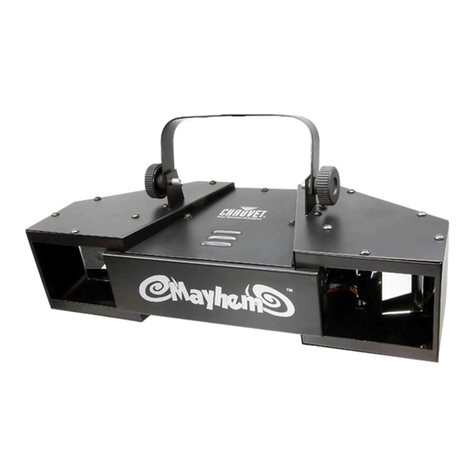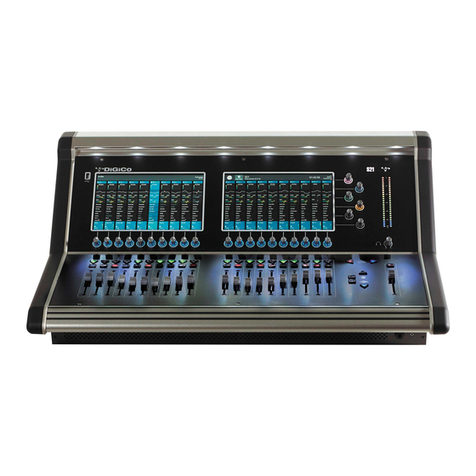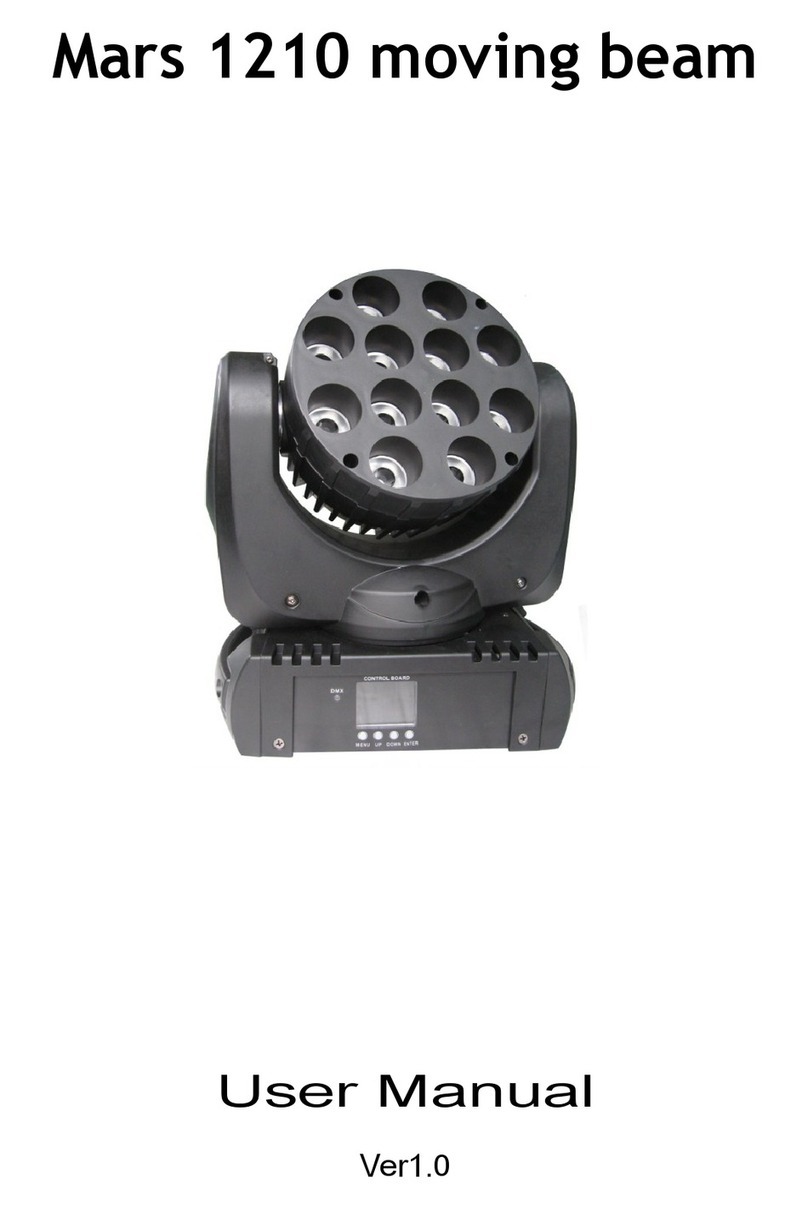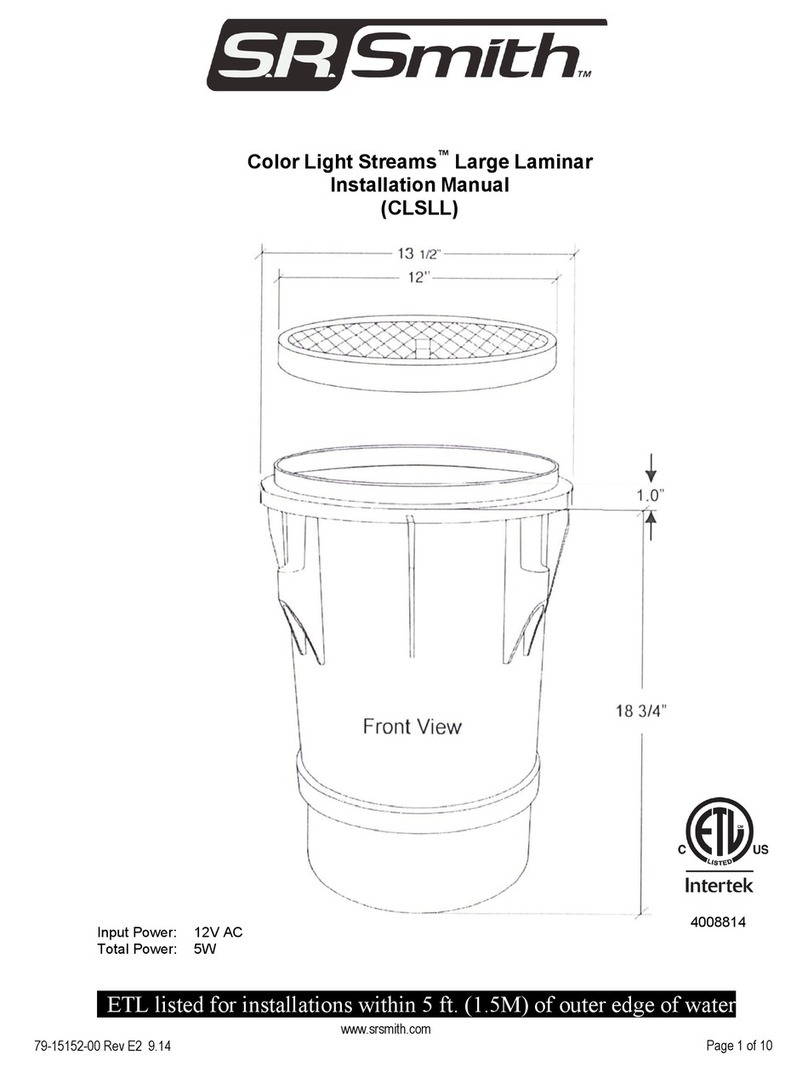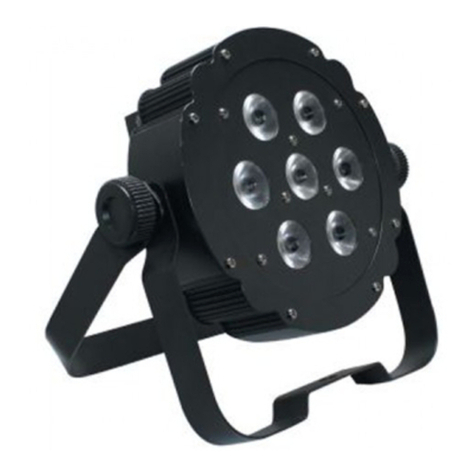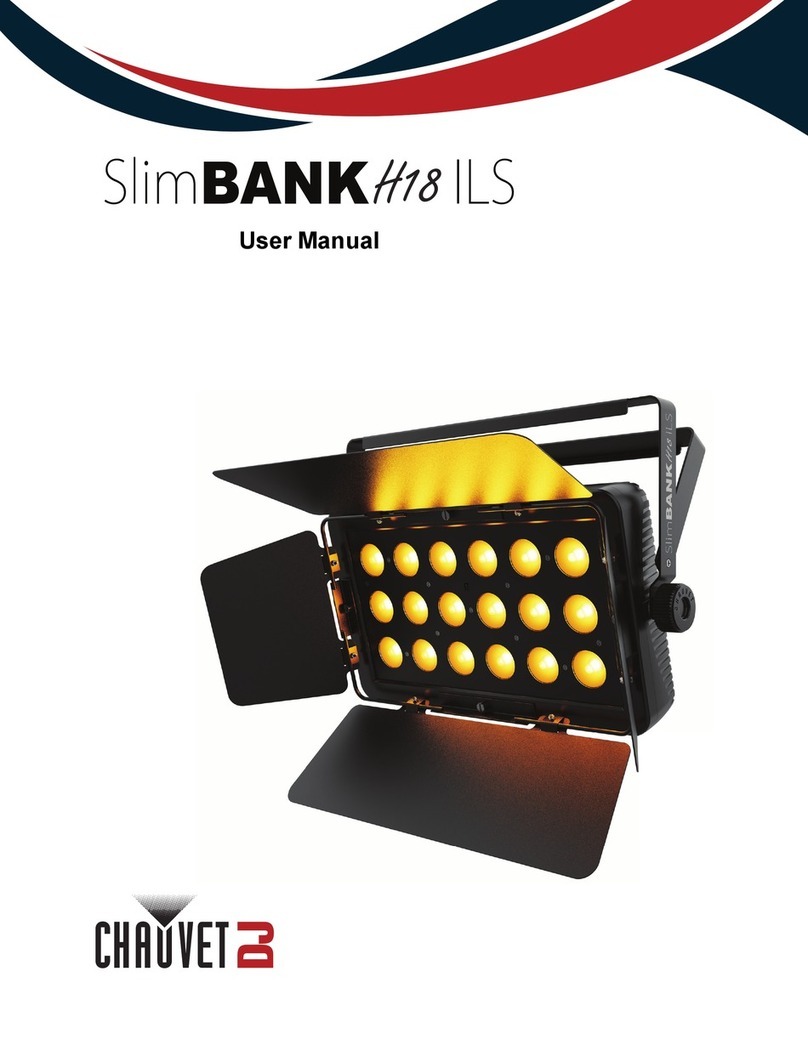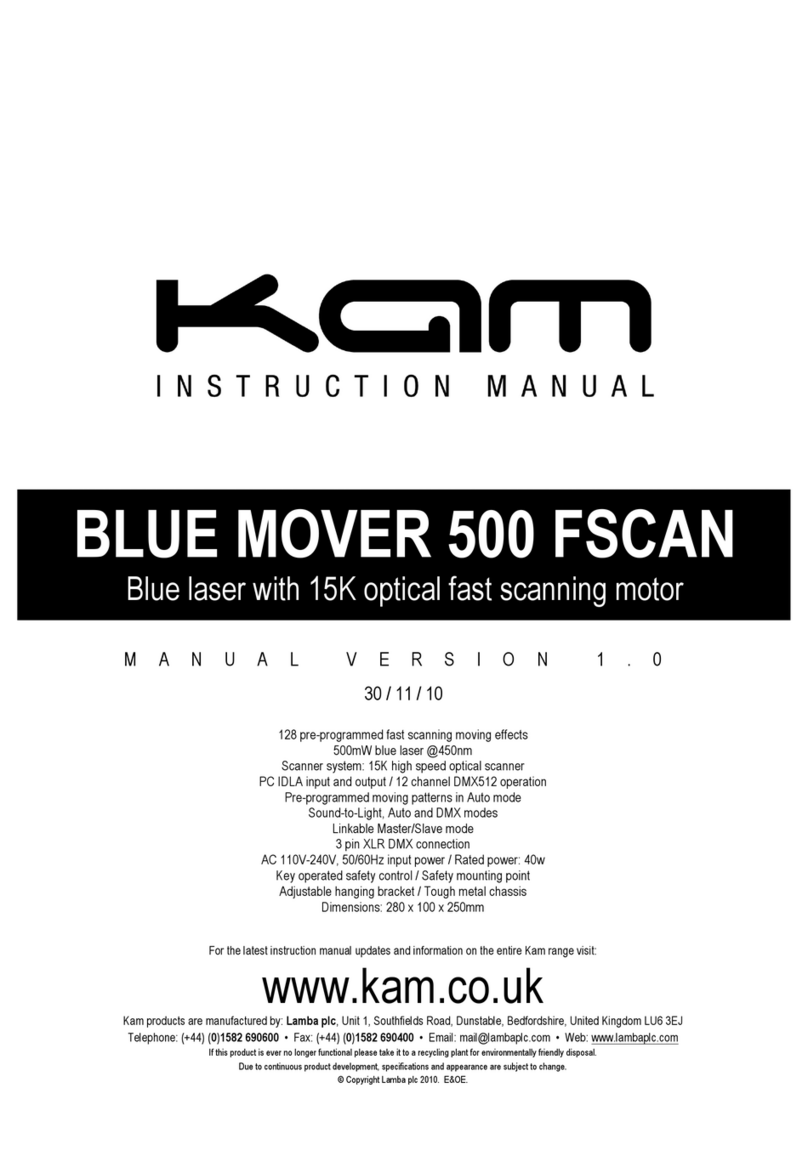Shark 0001 User manual

Safety informations page 2
Technicalfeatures page 3
Mainssupplyconnection page 4
Lampinstallation,replacementandsetting page 5
DMXsignalconnection page 6
Configurationandtests page 8
Automodefunctioning page 10
8 bit 6 channels mode selection page 11
16 bit 9 channels mode selection page 12
Electricdiagrams page 13
Troubleshooting page 16
Componentsandparts page 18
Technicaldrawings page 19
Systemboardconnection page 20
Appendix page 21
... 1 ...
ENGLISH INDEX
A SMALL FIXTURE FOR BIG PERFORMANCES

... 2 ...
WARNING
!SAFETY INFORMATION
READ ALL CAUTIONS AND WARNINGS PRIOR TOOPERATE THIS EQUIPMENT.
INSTRUCTION TO PREVENT INJURY OR DAMAGE DUE TO ELECTRIC SHOCK, FIRE, MECHANICAL HAZARDS AND
UV RADIATION HAZARDS.
•PROTECTION AGAINTS FIRE
1) This equipment is designed for use with the following lamps only: HTI 150W (OSRAM).
DO NOT USE ANY OTHER TYPE OF LAMP!
2) Maintain minimum distance of 0.3 meter from walls or any other type of flammable surfaces.
3) Maintain minimum distance to lighted objects of 1.0 meter.
4) Replace fuses only with the specified type and rating.
5) Do not install the spot close to heat sources. Do not lay the connection cable on the spot when it is warm.
•PROTECTION AGAINST ELECTRIC SHOCK
1) This equipment must be earthed.
2)ClassIequipment.Thepowersupplycordincludesaprotective earthing conductor as part of the cord. See page 4, pict.1a.
3) For connection to the mains supply proceed as pict.1 page 4.
4)Disconnectpowerbeforelampreplacement or servicing (service personnel).
5) Do not install the spot outdoor, directly exposed to the rain or moisture.
•PROTECTION AGAINST MECHANICAL HAZARDS
1) Use safety chain when fixing this equipment.
2) Hot lamp explosion hazard. Do not open the equipment for five minutes after switching off.
3) Equipment surface may reach temperature up to 85°C. Allow about five minutes before handling.
4) Replace the lamp if it is damaged or thermally deformed and, in any case, not over lamp life.
•PROTECTION AGAINST UV RADIATION HAZARDS
1)Donotstartonthisequipmentwithoutlampenclosureoriftheprotectionscreens,orultravioletsscreensaredamaged.
2) The protection screens, the lenses, or the ultraviolet filters must be replaced if they are visibly damaged and their effectiveness
hasbeenreduced,for example, bycracksordeepscratches.
3) Do not look directly at the lamp while lamp is on.
INTRODUCTION
Thank you for using the SHARK, a small fixture for big performances.
Thefixturecompletely manufacturedinlightalloy andplasticmaterial,with anopticsystemof incredibleperformanceanda modern
andreliableelectronics, can besmartlyusedanywhere.
•Art. 0001 SHARK for HTI 150W discharge lamp.
Theinputprotocolisthe DMX 512. To drive the SHARK we suggest to use either our controller Mini Control 32 (with DMX board), or
the DMX Control Spot, which can drive the SHARK 16 bit obtaining the maximum displacement resolution.
To make the most of its possibilites and for a correct functioning of this unit in the years to come, we suggest you to read carefully
thismanualbefore connecting or puttingthespotintouse. By doingsoyouwillgain experience with itscommandsandconnections
and you will be easily able to use it.

... 3 ...
YOUR REFERENCE
Always remeber to give the serial number and to specify the model any time you address the seller for information or assistance.
BASIC KIT
The basic kit of the SHARK motorized spot consists of:
•Projector
•Powerconnector
•Lamp(uponrequest)
•User’smanual
•StudioDuewarranty
WARNING
!
Check that the spot has not been damaged during transport. If it has been damaged or it does not work,
address the seller. Whether the spot has been shipped to you directly, please contact the shipping company.
Only the consignee (person or company) can claim for these damages.
TECHNICAL FEATURES
LAMP
Discharge HTI 150W (OSRAM)
MOVEMENTS
Bothhorizontalandverticalmovementstakeplacesmoothly.Thisispossiblebyusingasofisticatedmicrosteppercontrolsystem
of 16 bit stepper motors.
HORIZONTAL MOVEMENT
Pan 365°. Revolution time: min. 1.5 sec max. 400 sec. 16 bit resolution.
VERTICALMOVEMENT
Tilt 270°. Revolution time: min. 1.2 sec max. 400 sec. 16 bit resolution.
COLOURS
n.1 colour wheel with seven colours + white. The wheel can rotate (rainbow effect) at four different speeds.
GOBOS
n.1 gobos wheel with seven gobos. The wheel can rotate (rainbow effect) at four different speeds.
STROBO/BLACKOUT/DIMMER
Blackout and strobe effect with selectable speed. (min. 1 flash/sec. max. 8 flash/sec.). The shutter can work as dimmer.
POWERSUPPLYINPUT
• Rated voltage: 230 Vac; 50 Hz
onrequest 208 Vac; 60 Hz
200 Vac; 50 Hz
117 Vac; 60 Hz
100 Vac; 50 Hz
• Rated voltage: 250 W
•Rated current: 1,1 A (230 Vac)

®
... 4 ...
pict. 1/a
MALE3PINCONNECTORFOR POWER INPUT
pict. 1
BEFORE USING
Readall cautionsandwarningson page1prior toinstallthis equipment.Particularly,readthe follow:
1)Disconnectpowerbefore lamp’s replacementorservicing(servicepersonnel)
2) Do not open the lamp cover for five minutes after switching off
3) Wear gloves and goggles to re-lamping or to work inside the unit (service personnel)
Before connecting the equipment to the power system:
Make sure that the mains voltage and frequency correspond to the rated values. (pict.1)
The SHARK is made for a mains voltage 230V 50/60 Hz; 2A
For a power supply of 100V-120V it is necessary to use one auto transformer with the following features:
• Output voltage 230V
• Output current 2A
Thepowersupplyconnectionisshowninpict.1/a.
1a) Do not install the spot close to heat sources. Do not lay the connection cable on the spot when it is warm.
1b) This unit must be positioned as to allow its ventilation. Be careful not to occlude the in-out air grilles.
1c) The unit must be positioned at least 30cm. from walls or other flammable surfaces.
Observe minimum distance to lighted objects of 1.0 meter.
Externalsurface temperature:
• After 5 minutes work; Tc=65°C.
•Oncethethermicbalance has been obtained; Tc=85°C.
4)Theprotection screens,thelenses,or theultravioletfiltersmust bereplacedifthey arevisiblydamaged and theireffectivenesshas
beenreduced,for example,bycracksor deepscratches.
5) Replace the lamp when the lamp life is exhausted (750 hours) to avoid bad performances of the fixture or that the optic system is
damaged by the lamp explosion.
6)Cleanregularlythe in-out air grilles.
7) In case of installation of the spot to a truss, check carefully that the security ring is well fixed with a chain to both truss and unit.
Do not handle the spot by taking it by the bracket, but always by the base.
8) Do not install the spot outdoor, directly exposed to the rain or moisture.
The equipment must be earthed.
If this rule is not followed, the warranty will be void.
WARNING
!
L = LIVE (Brown)
N = NEUTRAL (Blue)
=EARTH (GreenYellow)
ACIN
POWER
OUT•DMX•IN
MAIN FUSE
Pin1•GND
Pin2•SIG-
Pin3•SIG+
LN

O
P
E
N
O
P
E
N
L
A
M
P
S
A
D
J
U
T
L
A
M
P
A
D
J
U
S
T
L
A
M
P
A
D
J
U
S
T
D
IS
C
O
N
N
E
C
T
P
O
W
E
R
A
N
D
W
A
I
T
3
0
0
S
E
C
.
B
E
F
O
R
E
O
P
E
N
I
N
G
LAMP HTI 150 GY9.5
O
P
E
N
O
P
E
N
L
A
M
P
S
A
D
J
U
T
L
A
M
P
A
D
J
U
S
T
L
A
M
P
A
D
J
U
S
T
D
IS
C
O
N
N
E
C
T
P
O
W
E
R
A
N
D
W
A
I
T
3
0
0
S
E
C
.
B
E
F
O
R
E
O
P
E
N
I
N
G
LAMP HTI 150 GY9.5
pict.2/a
... 5 ...
LAMPSETTINGNUT
pict.3
PAWLS(A)TOOPENTHE LAMP HOLDER
pict.2
INSTALLATION OF THE LAMP
1)Disconnectpowerbeforelamp’sreplacement. Wear gloves and goggles.
2) Unscrew the pawls (A) on the back of the head fixture. (pict.2)
3) Open the lamp’s holder on the back of head fixture. (pict.2/a)
4) Insert the lamp into the lamp holder socket (pict.2/a).Donottouchthequarzbulbwithfingers.If this happens, clean the bulb
before usewithclothandalcohol.Polish withadry cloth.
5) Close the lamp holder; one security switch will prevent the switching on.
In case of replacement of the lamp or maintenance, do not open
the fixture unless 5 minutes have passed from the switching off.
WARNING
!
LAMP SETTING
Operateonthelamp setting nuts (lamp adjust)onthelampholder (pict.3). So to havethemaximumofthe brightness and maximum
uniformityoftheglowdischarge.

ControlSpot
789
456
123
0
ControlSpot
789
456
123
0
ControlSpot
789
456
123
0
ControlSpot
789
456
123
0
EXAMPLES OF CONNECTION DMX CONTROLLER - SPOT
DMXCONTROLLERORLIGHTCONSOLE
DMXCONTROLLERORLIGHTCONSOLE
EXAMPLE 1
Connection controller-spot with
1 DMX 512 OUTPUT
EXAMPLE 2
Connection controller-spot with
2 or more DMX 512 OUTPUT
EXAMPLE 3
Connection controller-spot to
1 DMX 512 OUTPUT over 150mts long
EXAMPLE 4
Connection controller-spot to
1 DMX 512 OUTPUT over 150mts long
TERMINATIONRESISTOR
LASTSPOT
LASTSPOT
SIGNAL AMPLIFIER
SPOTSPOTSPOT
SPOTSPOTSPOT
SPOTSPOT
... 6 ...
TERMINATIONRESISTOR
DMXCONTROLLERORLIGHTCONSOLE
DMXCONTROLLERORLIGHTCONSOLE
TERMINATIONRESISTOR
SIGNAL AMPLIFIER
TERMINATIONRESISTOR
TERMINATIONRESISTOR
LASTSPOTSPOTSPOTSPOT
LASTSPOTSPOT
LASTSPOT
SPOT
DMX TERMINAL LINE
Thewrong connectionofthe terminallineorits non-connectionareprobablythemost frequentreasonsforthedefectivefunctioning
ofthe DMX line. The terminator is a resistorfittedbetweenthetwo “data” lines (pins 2 and 3 ofanXLR3pinconnector) at the end of
thecablefurthest from thetransmitter.Theterminator resistor shouldhavethesame value astheimpedanceof the connectioncable.
We suggest to use a terminal with a 100 Ohm resistor.
It is recommended that all DMX 512 systems have the termination resistor at the and of the line.
WARNING
!
DMX1 output/linea uscita DMX1
DMX2 output/linea uscita DMX2
LINE>150mts(withmicrophonic or audiocable)
LINE>150mts(withmicrophonic or audiocable)

... 7 ...
pict.4 pict.4/a
pict. 5
CONNECTION TO THE DMX SIGNAL
The connection of the DMX signal to the SHARK must be mabe by using the signal input XLR 3 pin connectors which are located on
the control panel of the SHARK. (pict.4)
The pin nomenclature of the connectors for the connection to the DMX signal is listed in the table. (pict.4/a)
Inordertoavoidanyprobleminthesignaltransmission,itiswarmlysuggestedtouseacableforhighspeeddatatransmission.
Theusageof a normal microphonic or audio cable is suggested only forlinesmax100mtslong.Thebestperformances are with
microphonic cable of mm2x0.25 + ground or with cable for data trasmission. If the lines have a total length over 150-200 mts it is
suggested to use our DMX Repeater Amplifier.
CONTROL PANEL
On the control panel of the SHARK (pict. 5) you can find, besides the display, the leds and the buttons to use to set the spot.
LED
•“DMX”led flashing: DMX input present
off: no DMX input
• ”LAMP OFF” led flashing: the lamp switching off is remotely controlled
off: lampswitchedon
BUTTONS
Fourbuttonsareusedto programme the spot:
•MENU toselectthe programming options
• Down togobackwardintheselectedoptions
• Up to go forward in the selected options
•Enter to confirm the selected options
DISPLAY
Shows the various menus and the selected options.
PIN WIRE SIGNAL
1SHIELD GROUND/RETURN/OV
2INNER CONDUCTOR DATA COMPLEMENT ( -, INVERTED)
3INNER CONDUCTOR DATA TRUE ( +, NON INVERTED)
MENU
LAMPOFF
DMX
ENTER
DOWN UP
R

... 8 ...
About twenty seconds after the switching on, the number of the software version will be shown on the display in “X_00” format.
Afterwards the first of the thirteen available menus will appear:
• Addr to assign the DMX-512 address
• Mode DMX512 mode, master with pre-set selection, slave
• PrSP speed of execution of the pre-stored programmes
• LHrs lampworkinghours
• FHrs fixturetotalworking hours
• NChn channelsnumber
• StMd strobemode
• CGMd Color/Gobomode
• Ipan paninversion
• Itlt tiltinversion
• Test auto-test
• FLIP displayinversion
• Rset reset of the spot
To select any of the given options, press the MENU button up to when the required one is shown.
Addr (Address)
TovisualisetheDMX address press ENTER.
Tomodifythe addresspressDownand Upbuttonsand,once therequiredaddresshas beenselected,press andkeep ENTER pressed
uptowhen the displaystopsflashing(it flashestoindicatethat the selectedoptionisdifferent from thepre-setone).To gobacktothe
optionswithout making any change, press the MENU button.
Mode (Mode)
TovisualisethismodepressENTER.
Use Down and Up buttons to change the mode and, once the required one has been selected, press and keep ENTER pressed up
to when the display stops flashing (it flashes to indicate that the selected option is different from the pre-set one). The available op-
tions are: no (normal) for the functioning in DMX reception; Pr01…Pr04 (pre-set 01…04) for the master functioning with the re-
spective game, SL (slave) for the functioning as slave. It is possible, through the PrSP menu, to set the speed of execution of the
game. To go back to the options without any change, press the MENU button.
PrSp(ProgramSpeed)
This option is only available if the spot is set as master (Pr1-Pr4).
To visualise the speed press ENTER.
One number from 1 to 16 will be shown. The number stands for the speed of execution of the game: 1 minimum, 16 maximum. To
change the speed use Down and Up buttons and, once the required speed has been selected, press and keep ENTER pressed up to
when the display stops flashing (it flashes to indicate that the selected option is different from the pre-set one). To go back to the
optionswithout making any change, press the MENU button.
SUMMARY OF THE PROGRAMMING FUNCTIONS OF THE SHARK
Addr
Mode
PrSP
LHrs
FHrs
NChn
StMd
CGMd
Ipan
Itlt
Test
FLIP
Rset

... 9 ...
LHrs (Lamp Hours)
Tovisualise thenumber of working hours of lamp press ENTER.
The maximum countable number of hours is 2000. Exceeding this number, the display will show gr2t (greater than 2 thousands). To
resetthe counterpresssimultaneouslybuttonsDown andUP:thedisplaywill showCLLH(clearlamphours).To gobacktotheoptions
withoutmaking any change, press the MENU button.
FHrs(Fixturehours)
To visualise the number of working hours of fixture press ENTER.
The maximum countable number of hours is 2000. Exceeding this number, the display will show gr2t (greater than 2 thousands). To
reset the counter press simultaneously buttons Down and UP. A control of the memory will be run and all the default settings will be
stored: the display will then show Init. If the memory is damaged, the display will show the message FAIL. To go back to the options
withoutmaking any change, press the MENU button.
NChn (Number of Channel)
TovisualisethenumberofchannelpressENTER.
UseDown andUpbuttonstochangethechanneland,oncethe requiredonehas beenselected,press andkeepENTER pressedupto
when the display stops flashing (it flashes to indicate that the selected option is different from the pre-set one). It is possible to set 6
channels (8 bit) or 9 channels ( 16 bit). To go back to the options without making any change, press the MENU button.
StMd (Strobe Method)
TovisualisethismodepressENTER.
Use Down and Up buttons to change the mode and, once the required one has been selected, press and keep ENTER pressed up to
whenthedisplaystopsflashing (it flashes to indicate that the selected option is different from the pre-set one). It is possible to set: 1
(strobewithoutdimmer),2(strobewithdimmer),3(strobe Compulite).Togobacktotheoptionswithoutmakinganychange,pressthe
MENUbutton.
CGMd(Color-Gobo Method)
Tovisualisethecolor-gobo mode press ENTER.
Use Down and Up buttons to change the mode and, once the required one has been selected, press and keep ENTER pressed up to
whenthedisplay stops flashing(itflashestoindicate that theselectedoptionisdifferent from thepre-setone).Itis possible to set:no
(normal)wheels withcolor-goboselection, CP(continuouspositioning) wheelswithcontinuous positioning.Togo backtotheoptions
withoutmaking any change, press the MENU button.
Ipan(Pan Inversion)
Tovisualise the pan mode press ENTER.
Use Down and Up buttons to change the mode and, once the required one has been selected, press and keep ENTER pressed up to
whenthedisplay stopsflashing(itflashes to indicatethattheselected optionisdifferentfrom the pre-setone).Itis possibletoset:no
(normal)normalpan,PI(paninversion). To go back to the options withoutmakinganychange,presstheMENUbutton.
Itlt(TiltInversion)
To visualise the tilt mode press ENTER.
Use Down and Up buttons to change the mode and, once the required one has been selected, press and keep ENTER pressed up to
whenthedisplay stopsflashing(itflashes to indicatethattheselected optionisdifferentfrom the pre-setone).Itis possibletoset:no
(normal)normaltilt,Tl(tiltinversion).Togobacktotheoptionswithoutmakinganychange,presstheMENUbutton.
Test (Autotest)
Toinsertthe auto-test pressENTERandkeep it presseduptowhenthe display showstheflashingmessage t-on (test on).Totakeoff
the auto-test press the MENU button. To go back to the options without making any change, press the MENU button.
FLIP (Display overturning)
Thedisplayvisualisationcanbestandard oroverturned:bypressingtheENTERbuttonthetwomodeswillbealternativelyvisible.The
selected one will be immediately stored in the spot setting.
To go back to the options without making any change, press the MENU button.
Rset (Reset)
To run the complete reset press ENTER and keep it pressed up to when the display shows the flashing message r-on (reset on).
Once the reset procedure has been completed the spot will go back to the normal setting. To go back to the options without mak-
ing any change, press the MENU button.

EXAMPLE OF CONNECTION AND SETTING OF 4 SHARK IN SYNCHRO - MODE
EXAMPLE OF CONNECTION AND SETTING OF 4 SHARK IN INDIPENDENT AUTO - MODE
... 10 ...
PR1 PR2 PR3 PR4
PR1 SLAVE SLAVE SLAVE
USE OF THE SHARK IN AUTO-MODE
Press theMENU button on the control panel up to when the option MODE (pict. 6) is shown on the display, select it by pressing
ENTER and the set indication will appear (no...SL). UseDown and Up buttons to change the mode and, once the required one has
been selected, press and keep ENTER pressed up to when the display stops flashing (it flashes to indicate that the selected option
isdifferentfromthe pre-set one). The available options are: no (normal) for the functioning in DMX reception; Pr01…Pr04 (pre-set
01…04) for the master functioning with the respective game, SL (slave) for the functioning as slave. It is possible, through the
PrSP menu, to set the speed of execution of the game. To go back to the options without any change, press theMENU button.
PrSp(ProgramSpeed)
This option is only available if the spot is set as master (Pr1-Pr4).
To visualise the speed press ENTER.
One number from 1 to 16 will be shown. The number stands for the speed of execution of the game: 1 minimum, 16 maximum. To
change the speed useDownandUp buttons and,oncetherequiredspeedhas been selected,press andkeepENTERpressedupto
when the display stops flashing (it flashes to indicate that the selected option is different from the pre-set one).
MODE no use of the Shark in DMX-512
Pr1 master functioning with execution of the stored programme n. 1
Pr2 master functioning with execution of the stored programme n. 2
Pr3 master functioning with execution of the stored programme n. 3
Pr4 master functioning with execution of the stored programme n. 4
SL use of the Shark in SLAVE MODE
pict. 6
MENU
LAMPOFF
DMX
ENTERDOWN UP
R

... 11 ...
Spot n° 1 Spot n° 2 Spot n° 3 Spot n° 4
Canali1-6 Canali7-12 Canali13-18 Canali19-24
pict. 7
USE OF THE SHARK IN DMX 512
It is possible to choose a reduced resolution (8 bit) for the PAN/TILT motion of the Shark by occupying 6 DMX channels, or a
high resolution (16 bit) by occupying 9 channels.
8 BIT MODE SELECTION
Press theMENU button on the control panel up to when the option nChn is shown on the display, select it by pressing ENTERand
the set indication will appear (6 or 9 channels). For 8 bit performance you must set 6 channels on the display. Pass through the
numbers by pressing the buttonsUp and Down: once you have set the required number, store it by pressing theENTERbutton
and keep it pressed up to when the display stops flashing (the flashing shows that the selected option is different from the one
previously stored). To exit from the selected option without making any change press theMENU button.
When set to work at 8 bit the Shark needs 6 channels to control the following functions and the correspondence channel/function
is listed below
ChannelNo. Spot Function
1Motorsspeed
2Colorwheel+Rainbow
3Rotatinggobowheel +continuousrotation
4Dimmer,shutterand strobe
5Panmotion
6Tiltmotion
The complete listing of the DMX values is shown on appendix “A”, page 21.
CHANNELS ASSIGNMENT IN DMX 512 (8 BIT)
ADDRESS SELECTION
Press the MENU button on the control panel up to when the Addr option is shown on the display, select it by pressing theENTER
buttonandthe starting address willbeshown.You can modifyitthroughthe UpandDownbuttons asshowninpict. 7. Onceyouhave
settherequirednumberstoreitby pressingtheENTER button andkeepitpressed up to whenthedisplaystops flashing(theflashing
shows that the selected option is different from the one previously stored). To exit from the selected option without making any
change press theMENU button.
Pict. 7 shows the correct channels to be used to drive 4 SHARK (8 bit, 6 channels) in DMX 512.

pict. 8
USE OF THE SHARK IN DMX 512 (9 CHANNELS, 16 BIT)
16 BIT MODE SELECTION
Press the MENU button on the control panel up to when the option nChn is shown on the display, select it by pressing ENTER
and the set indication will appear (6 or 9 channels). For a better 16 bit performance you must set 9 channels on the display. Pass
through the numbers by pressing the buttonsUp and Down: once you have set the required number, store it by pressing theEN-
TER button and keep it pressed up to when the display stops flashing (the flashing shows that the selected option is different from
the one previously stored). To exit from the selected option without making any change press theMENU button.
When set to work at 16 bit the Shark needs 9 channels to control the following functions and the correspondence channel/function
is listed below
ChannelNo. Spot Function
1Motorsspeed
2Colorwheel+Rainbow
3Rotatinggobowheel +continuousrotation
4Dimmer,shutterand strobe
5Panmotion
6Panfine
7Tiltmotion
8Tiltfine
9Reset + lamp switching off
The complete listing of the DMX values is shown on appendix “B”, page 22.
CHANNELS ASSIGNMENT IN DMX 512 (16 BIT)
ADDRESS SELECTION
Press theMENU button on the control panel up to when theAddr option is shown on the display, select it by pressing theENTER
buttonandthe startingaddresswillbe shown.YoucanmodifyitthroughtheUp andDownbuttonsasshowninpict. 8.Onceyouhave
settherequirednumberstoreitby pressingtheENTER button andkeepitpressed up to whenthedisplaystops flashing(theflashing
shows that the selected option is different from the one previously stored). To exit from the selected option without making any
change press theMENU button.
Pict. 8 shows the correct channels to be used to drive 4 SHARK (16 bit, 9 channels) in DMX 512.
... 12 ...
Spot n° 1 Spot n° 2 Spot n° 3 Spot n° 4
Canali1-9 Canali10-18 Canali19-27 Canali28-36

... 13 ...
E
1
D
2
K
3
C
4
D
P
5
G
1
0
F
9
K
8
A
7
B
6
DS1
E
1
D
2
K
3
C
4
D
P
5
G
1
0
F
9
K
8
A
7
B
6
DS2
E
1
D
2
K
3
C
4
D
P
5
G
1
0
F
9
K
8
A
7
B
6
DS3
E
1
D
2
K
3
C
4
D
P
5
G
1
0
F
9
K
8
A
7
B
6
DS4
1 16
2 15
3 14
4 13
5 12
6 11
7 10
89
R80
1 2
C84
1
2
C83
V
C
C
1
5
G
N
D
5
X1
6
X2
7
P0.01
P0.120
P0.219
P0.318
P0.417
P0.516
P0.614
P0.713
P1.0/TX
12
P1.1/RX
11
P1.2
10
P1.3
9
P1.4
8
P1.5
4
P1.6
3
P1.7
2
U17
87LPC764
1
2
C80
1
2
C81
1
2C82 CS
1SK2
DI3
DO4
U16
1
2
C69
U16 1
2C88
U19
R86
R87
R90
1
2
3
4
5
12
U19A
R1
RE2
V
C
C
8
G
N
D
5
DE3
D4
A
6
B
7
U1
75176
1
2
C26
RPU2R1R2
A2
K3
VCC
8
GND
5
VB
7
VO
6
U2
6N137
1312
U19F
1
2
C85
1
2C86
1
2
C87
12XT3
X012
X114
X215
X311
Y01
Y15
Y22
Y34
INH6
A10
B9
X
13
Y
3
U18
LD1
12
U19A
LD2LD3LD4
12
U19A
12
U19A
987654321
R31
1 2
C35
12C36 R32 R36 R37 R38
1 2
C46
VR1
7
PH1
9
DS1
10
VR2
16
PH2
14
DS2
13
MA13
MB11
E12
K18
E221
K215
V
C
C
1
2
G
N
D
1
8
G
N
D
1
7
G
N
D
6
G
N
D
5
RC
11
VMM1
4
VMM2
19
MA220
MB222
U7R99
1
2
3
4
M2
GOBOS
R40
R39
1
2
C47
R98
1
2
3
4
5
6
R33
R34
1
2
3
4
5
6R35
1
2
C42
1
2
C43
1
2
C44 1
2
C45
P0.039
P0.138
P0.237
P0.336
P0.435
P0.534
P0.633
PSEN29
ALE30
EA31
P2.728
P2.526
P2.425
P2.324
P2.223
P2.122
P2.021
P2.627
P0.732
V
C
C
4
0
G
2
0
X
1
1
9
X
2
1
8
RXD
10
RST
9
P1.0
1P1.1
2P1.2
3P1.3
4P1.4
5P1.5
6P1.6
7P1.7
8
P3.1
11 P3.2
12 P3.3
13 P3.4
14 P3.5
15 P3.6
16 P3.7
17
U6
1
2
3
4
5
6
R25
R75
MENU
12
U19A
R24
987654321
R81
ENTER
UP
R4
DOWN
R3R5
A
2
K
3
VCC 8
GND5
VB7
VO6
U3
6N137
1
2
C27
1
2
C28
1 2 C24
1 2 C25
RP1
Z2
1
2
PTC2
Z1
123
DMXIN
1
2
PTC11 2
PTC3R6
A2
K3
VCC
8
GND
5
VB
7
VO
6
U4
6N137
12C29
1
2
3
4
5
TODISPLAY
BOARD
1
2
C4
R83RS11
2
C33 1
2
C34
V
C
C
1
5
G
N
D
5
X1
6
X2
7
P0.01
P0.120
P0.219
P0.318
P0.417
P0.516
P0.614
P0.713
P1.0/TX
12
P1.1/RX
11
P1.2
10
P1.3
9
P1.4
8
P1.5
4
P1.6
3
P1.7
2
U5
87LPC764
1
2
C37
R26 R27
R28
1
2
3
4
5
6R29
1
2
3
4
5
6R30
R42 R43
R44
R42 R41
1
2C48
1 2
C49
VR1
7
PH1
9
DS1
10
VR2
16
PH2
14
DS2
13
MA13
MB11
E12
K18
E221
K215
V
C
C
1
2
G
N
D
1
8
G
N
D
1
7
G
N
D
6
G
N
D
5
RC
11
VMM1
4
VMM2
19
MA220
MB222
U8
R96
R97
1
2
3
4
M1
COLORS
R46
R48
R45
R47
1
2
C55
1
2C56
1
2
C50
1
2
C51
1
2C54
1
2
C53
1
2
C18
12XT1
R60 R61 R62
1 2
C38
12C39
1 2
C72
R19
1
2C32
1 2
L3
12XT2
1
2
C31
1 2
C9
300V
NTC1
R8
D2
1
2
C2 1
2
C1 1
2
VR1
12
MAIN
TOPOWERNGPCB
1
2
C71
2
C8
1
2
C10 1
2
C11
R9
R10
R11
Z4
12D3
12D4
12 3
45
U14
Z3
1
2
C3
R13
Z5
1 3
MF11
2
C20 1
2
C21
1 2
D5
1 2
D6
1 5
4 8
T1
38W
1
2
13W
1 5
4 8
5W4W
1 2
D7
R14
1 3
MF3
1 2 C89
1 2 C90
1
2
C16
+27
+5DMX
VIG
N
D
VO
U12
R22
1
2
C22
1
2
C23
Z7
1
2
C17
R82
R21
R58
R59
R65
1
2
C73
1
2
C74
1
2
C75 1
2C76
1
2
C77
VR1
7
PH1
9
DS1
10
VR2
16
PH2
14
DS2
13
MA13
MB11
E12
K18
E221
K215
V
C
C
1
2
G
N
D
1
8
G
N
D
1
7
G
N
D
6
G
N
D
5
RC
11
VMM1
4
VMM2
19
MA220
MB222
U11
R20
R49 R50 R51
R52
R53 1
2
C58
1
2
C59
R64
1
2
3
4
M4
TILT
R54
R56
1 2
C57
1
2
C64
VR1
7
PH1
9
DS1
10
VR2
16
PH2
14
DS2
13
MA13
MB11
E12
K18
E221
K215
V
C
C
1
2
G
N
D
1
8
G
N
D
1
7
G
N
D
6
G
N
D
5
RC
11
VMM1
4
VMM2
19
MA220
MB222
U9
R94
R95
1
2
3
4
M5
PAN
R55
R57 1
2C63
R63 1
2
C61
1
2
C60
1
2
C62
1
2
3
4
M3
SHUTTER
R66
R68 R69 R70
1 2
C65
1
2C78
VR1
7
PH1
9
DS1
10
VR2
16
PH2
14
DS2
13
MA13
MB11
E12
K18
E221
K215
V
C
C
1
2
G
N
D
1
8
G
N
D
1
7
G
N
D
6
G
N
D
5
RC
11
VMM1
4
VMM2
19
MA220
MB222
U10 R92
R93
R67
+5
R23
1
2
C40
1
2
C411 2
C15 VI
G
N
D
VO
U13
1
2C15
1
2
4
3U15
1
2
C91 1
2
C92
1
2
C12 1
2
C13
1
2
C14
R12
Z6
1
2
3+TOPOWERNGPCB
1
2D1
Q1
R75
1
2
C19
R85 R73
R74
1
2
C66
1
2
C67
1
2
C68 1
2C69
1
2
C70
1
2C71
R71
R72
DISPLAYPANEL
cod.PD
+5V
+5V
+5V+5V
VDD
+5V
+5V+5V
+30V
+5V
+5V
+5V
+5V
+5V
+5V
+5V
+5V
+5V
+5V
+30V
+5V
POWER
LAMPOFF
o
o
o
o(+5VOPTODMX)
+30V
GND
+VDD
+30V
+30V
+5V
+5V
+30V
+30V
Date:March8,2000 Sheet1of1
SizeDocumentNumberREV
D1.0
TitleNGIANT11

... 14 ...
•NGIANT11•
•PD1•

... 15 ...
•POWERNG•
1
2
CX1
1 2
MAIN FUSE
1
2CX2
1
2CY1
1
2
CY2
1 2
LD 12 1
2MAIN TO NGIANT11 PCB
1 2
FUSE 1.6AT
1 2
MF10
1
2
3
RET
+27V
1
2
LFL
LAMP ON
12 DRL
GND
1
2CR2
RL1
4
3
6
5
1 2
RL
1
2
CR1
1
2PFC 1
2
PFC 1 2CF1
RFB 1
2
FAN
+
1
2
BALLAST
1
2
BALLAST
123
IGNITER 123 TO HEAD
+
RFH
1 2
LAMP THERMAL FUSE
1
2HTI150
LAMP
POWERNG PCB
MAIN
POWER
-+
BASE FAN
+-
LND
IGNITER
HEAD FAN
Date: March 7, 2000 Sheet of
Size Document Number REV
A
Title
SHARK POWER ELECTRIC DIAGRAM

... 16 ...
TABLE A1 • GENERAL TROUBLESHOOTING
Problem Pilot-tests (guide) Probable causes Suggested solutions
The unit does not turn on,
the fans do not work.
The unit is completely
dead
Measure the mains
voltage on the main
connector.
If you have the right
value the main fuses
are blown
No power.
Power cord or
connectors.
Main fuses blown.
Connect power.
Replace the cables and
the connectors.
Replace the mains fuse
The fans work, the display
is turned off (no reset
when switching on, no
light).
The electronics do not
work.
Check that the leds on
the motor board
(NGIANTM PCB) are
turned on, particularly
check the +5V.
Short circuit on the +5V
line.
The R14 resistor has
blown.
General test on the +5V
line.
Replace the R14 resistor.
The unit works normally
but the lamp does not turn
on
Bad lamp.
Lamp is too hot to re-
strike.
Mains voltage is too low.
The igniter is not
working.
Wrong ballast wiring.
Replace the lamp.
Wait for the lamp
cooling
Measure the mains
voltage.
Replace the igniter.
Check the ballast wiring
(ref. POWERNG PCB)
The unit works normally
but the lamp does not turn
on.
The thermal on the
head of the fixture is
open.
The last DMX channel
on the controller (n. 9)
is set on a value>250
Too high temperature
inside the head.
The fan on the head is
not working
The air-in grilles are
stopped up.
The REMORE LAMP OFF
command is on.
Wait that the lamp
housing has cooled
down.
Check and if necessary
replace the fan.
Check and if necessary
replace the RFH resistor
Clean the grilles
Set the DMX channel on
0 value and/or set the
Shark for the 6 channels
functioning.
The lamp is cutting out
intermittently The lamp is not
working well.
The values reached by
the internal
temperature are too
high
The tension of the
power supply is either
too high or too low.
The fan on the head is
not working regularly
The air grilles are
stopped up.
Measure the mains
voltage.
Check and if necessary
replace the fan.
Check and if necessary
replace the RFH resistor
Clean the grilles
One of the function is not
working well(ie. GOBO) Disconnect the power.
Manually test if the
Gobo moves freely.
The stepper motor is
damaged or the cable
connected to the
controller pcb is broken
(ref. NGIANTM PCB).
The motor drive
(PBL3773) is broken.
Make all the tests
reported on page 20

... 17 ...
TABLE A2 • DATA LINK TROUBLESHOOTING
Problem Pilot-tests (guide) Probable cause(s) Suggested Solutions
None of the Sharks
responds to controller.
The DMX led is switched
off.
Make sure that all the units
are set in DMX mode.
After the configuration
starts the fixtures on.
The controller is not
connected to the fixtures.
The cable from the
controller to the first of
the Shark is interrupted
(or pin 2 and 3 are
swapped or the cables are
on short circuit)
Connect the controller
properly.
Use an already tested cable
and connect the fixtures
one by one.
One or more of the Sharks
do not respond to the
controller or do it wrongly.
The non-working fixtures
are always the same.
The fixtures work
accidentally. If one of the
connecting cables is
missing this may cause a
random malfunctioning in
addition to apparent
normal operation. If the
inverted-data is cut wire is
cut (pin. 2 on the DMX
connector) the line works
intermittently.
Wrong DMX address in
the fixture.
Wrong data cables, or
disconnected or shorted.
One fixture ahs a broken
DMX board.
DMX link not terminated.
Set the proper address
Check and if necessary
replace the cables.
Use a tested cable and
replace only one at a time.
Use a tested cable and
exclude only one fixture at
a time.
Insert the terminator on the
last fixture (pag.6)

... 18 ...
SPARE PARTS and TECHNICAL DRAWINGS
N° PARTS DESCRIPTION CODE NUMBER
1Upper head cover SDM 89000110
2Lower head cover SDM 89000120
3Lateral cover SDM 89000130
4Handle SDM 90100050
5Upper bracket cover SDM 89000140
6Glass holder SDM 00010010
7Glass 50x50x1.5 SDO 52000025
8Spacer SDM 80400681
9Lenses sliding guide SDM 80700012
10 Screw for lenses sliding guide SDM 80700014
11 Spiral spring SDM 80510110
12 Focus screw SDM 80410010
13 Lenses holder plate SDM 00010020
14 Lenses holder SDM 70000040
15 Lens SDO 10105010
16 Color raimbow wheel stop SDM 93010230
17 Stepper motor SDE 42142037
18 Clutch SDM 80300092
19 Spiral spring SDM 80510710
20 Raimbow support plate SDM 00010030
21 Fan plate SDM 00010040
22 Fan 60x60 SDE 10006020
23 Color wheel support SDM 80400037
24 Color wheel SDS 65000110
25 Gobos wheel support SDS 80400047
26 Gobos wheel SDS 65000120
27 Gobos and color motor support plate SDS 00010050
28 Spacer SDM 80400174
29 Dimmer SDM 00010060
30 Plate SDM 00010070
31 Spacer SDM 80400177
32 Dimmer support spacer SDM 80400119
33 Parabole support plate SDM 00010080
34 Spacer SDM 80400640
35 Parabole SDO 60000040
36 Spiral spring fixing parabole SDM 80500022
36/a Gum pipe SDM 80000000
37 Dimmer stepper motor SDE 42142040
38 Head connection P.C. SDS 62000150
39 Thermal switch SDE 34101250
40 Lamp socket SDO 30000070
41 Thermal switch support SDM 00010090
42 Lamp socket holder SDM 00010100
43 Spacer SDM 80400635
44 Lamp plate SDM 00010110
45 Lamp adjust plate SDM 00010120
46 Lamp plate nut SDM 90110020
47 Lamp adjust nut SDM 80410050
48 Spiral spring SDM 80510130
49 Motor counterbalance SDM 80400035
49/a Igniter SDS 62000190
N° PARTS DESCRIPTION CODE NUMBER
50 Reflector parabole counterplate SDM 97020100
51 Tilt switch SDE 34201600
52 Pan switch SDE 34201600
53 Switch support plate SDM 00010500
54 Ball bearing lock SDM 80910010
55 Pan lock screw SDM 80000000
56 Pan spacer SDM 80000000
57 Main board spacer SDM 80400120
58 Lamp SDO 22101502
59 Tilt switch support plate SDM 00010135
60 3 pin male connector SDE 35700020
61 3 pin female connector SDE 35700030
62 Tension switch SDE 34500010
63 Power input/fuse holder SDE 35300034
64 Fuse holder SDE 35300035
65 Tilt gum SDM 80000000
66 Head gum SDM 80000000
67 Tilt bolt SDM 80000000
68 Focus screw SDM 80000000
69 Pan lock spiral spring SDM 80000000
71 Bracket SDS 00010010
72 Head support cable side SDM 80700045
73 Head support motor side SDM 80700055
74 Tilt belt SDM 85371600
75 Stepper motor SDE 42142070
76 Tilt gear SDM 84200115
77 Motor spiral spring SDM 80500062
78 Ball bearing lock plate SDM 00010130
85 Pan driven belt SDM 84200110
86 Ball bearing SDM 86000080
87 Pan belt SDM 85301008
88 Pulley SDM 80103016
89 Condenser SDE 25000007
90 Magnetic ballast SDE 28515012
91 Pan plate SDM 90000250
92 Base bracket SDM 00010410
93 Lateral cover SDM 90300030
94 Fan support plate SDM 00010420
95 Control panel support plate SDM 00010425
96 Base fan SDE 10208000
97 Base panel SDM 00010450
98 Base cover (smooth) SDM 00010460
99 Base cover (with fold) SDM 00010470
100 Main board support SDM 00010480
101 Base cover SDM 89000150
102 Main board P.C. SDS 62000160
103 Control panel P.C. SDS 62000170
104 Mains filter P.C. SDS 62000180
105 Adhesive (connector side) SDV 90000200
106 Adhesive (menu side) SDV 90000300
107 Pan lock SDM 00010140
360
360320

... 19 ... •TECHNICAL DRAWINGS•
65
89
18
71
101
62
63
60
64
61
4
94
105
75 93
65
92
97
2
96
77 77
104
87
85
3
66
72
66
74
77
65
77
88
53
65
65
65
59
54
6
67
51
76
7
14 15
3
29
73
99
86
66
86
78
54
30
5
8
9
11
8
13
15
16 16
49 19
20
17
10
12
49
19 18
90
69
75
107
88
65
65 91
56
86
52
86
55
100
57
98
4
103
57
93
57
57
102
1
40
39
36/a
34
34
34
41
32
31
31
31
38
95
43
43
43
58
28
31
22
17
21
27
35
33
49/a
28
28
28
23
68
106
48
48
44
42
101
47
47
45
48
37
36
36
36
36
50
36/a
36/a
36/a
25
24
47
46 46
26

... 20 ...
SYSTEM BOARD CONNECTION
MOTOR BOARD
• POWER SUPPLY +30V Led On
• +5V Led
• +300V Led
• +5V DMX Led
•DMX signal
•Ledflashing: theDMXsignalisoperating on the board
• Led off: check the U1 (6N137) and the DMX connecting cable
• One of the stepper motor does not move (i.e. gobo):
1) Switch off the fixture and disconnect the gobo and color cables
2)Connectthegoboonthecolorconnector
3) Switch on the fixture:
3a) If the gobo motor works normally it is necessary to replace the U7 (PBL3773)
3b) Ifthemotoris still not working check with extreme attention the motor and the interconnecting circuits (cables and
connetors).
Tocheckthe cables and the motors you can measure the resistance as follows:
between PIN 1 and PIN3 (on IC U7, U8, U9, U10, U11)R=~18ohm;
between PIN 20 and PIN22 (on IC U7, U8, U9, U10, U11) R=~18ohm.
pict. 9
fig. 9
MAIN AC IN
TO POWER NG
COLORS
GOBOS
SHUTTER
PAN TILT + 5V LED
+ 5V DMX SW PAN
SW TILT
VR1 MAIN
OVERVOLTAGE
PROTECTION
MICRO MOTORS
MICRO
DMX
DMX IN
Table of contents
Popular Dj Equipment manuals by other brands
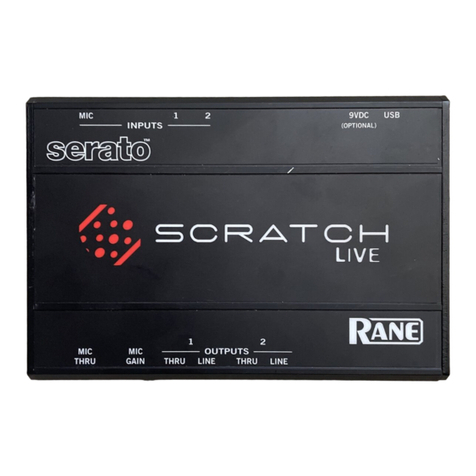
Rane
Rane serato SCRATCH LIVE quick start

American DJ
American DJ Super Jewel User instructions
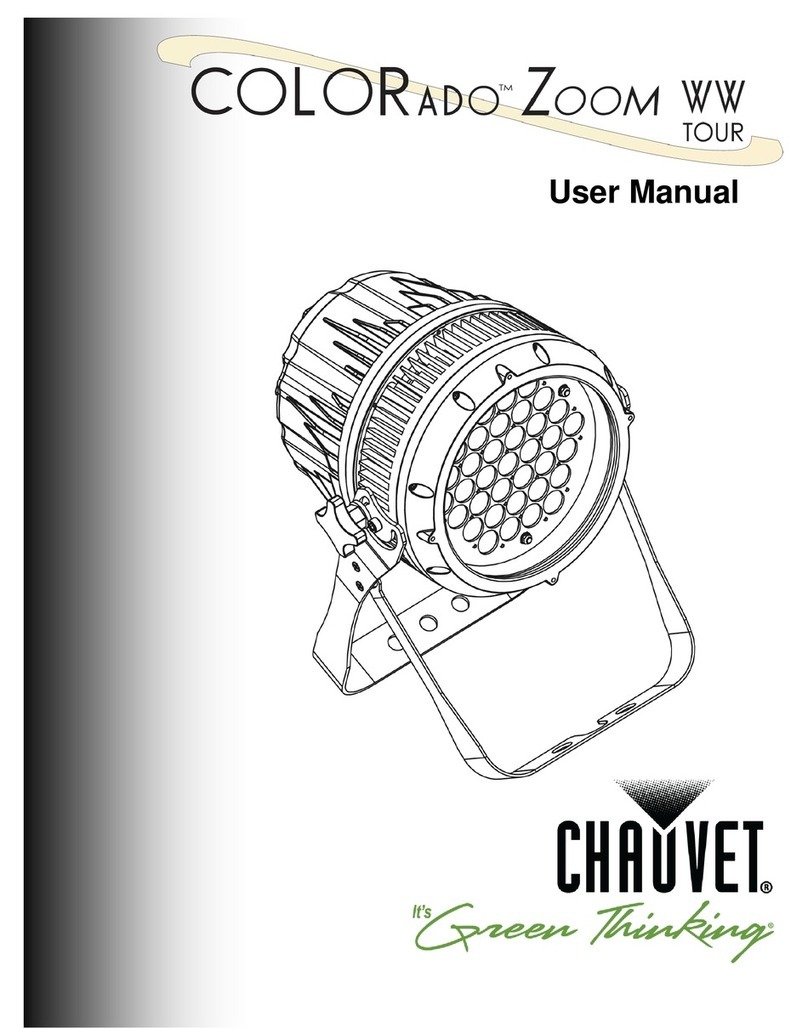
Chauvet
Chauvet COLORado Zoom Tour WW user manual
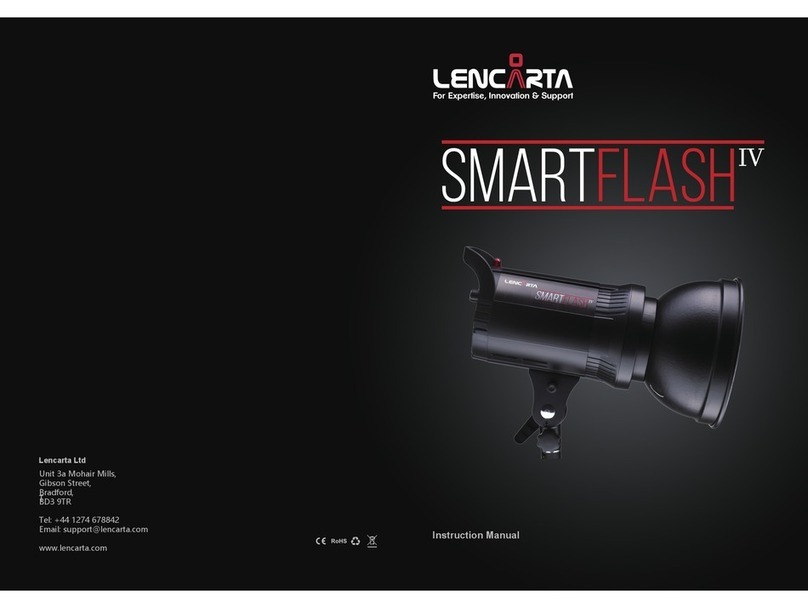
Lencarta
Lencarta SmartFlash 4 instruction manual

Chauvet Professional
Chauvet Professional MAVERICK FORCE 3 PROFILE Quick reference guide
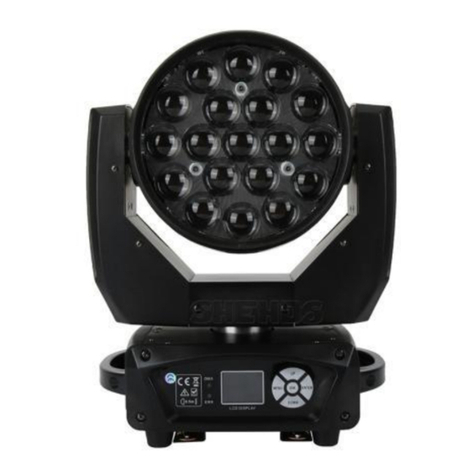
Shehds
Shehds LED Beam+Wash 19x15W RGBW Zoom Lighting user manual
